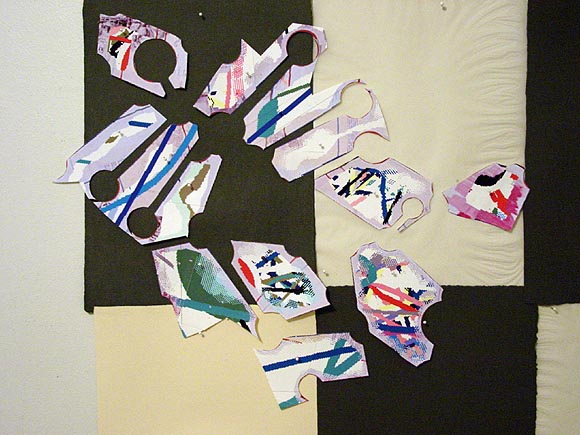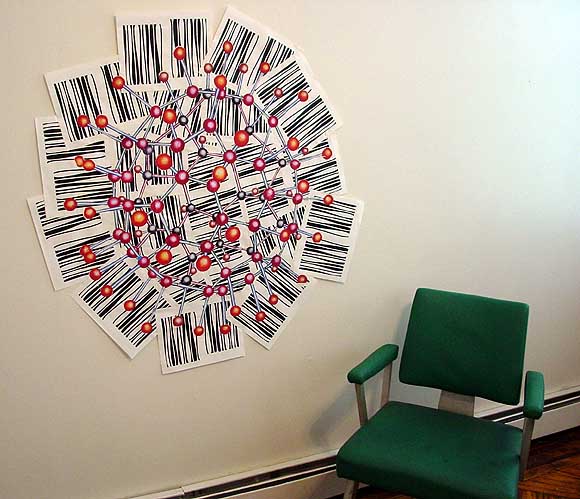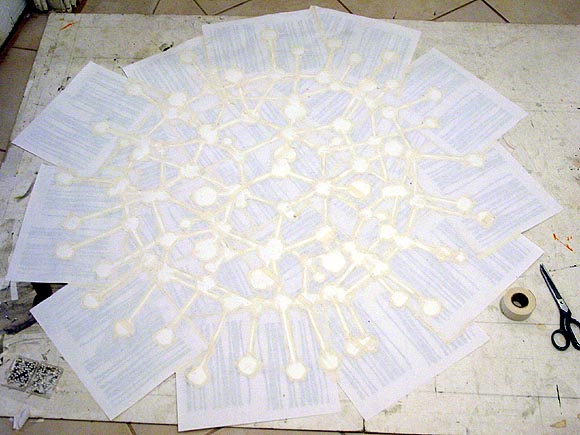View current page
...more recent posts
More on "extreme abstraction": Adolescent ranting aside, there is always the inherent contradiction of packaging work as extreme or "out there" when it's acceptable enough to curatorial and collector sensibilities to be in a major museum. I don't know David Batchelor's work but the rest of the choices in the Albright-Knox's "Extreme Abstraction" show are bread-and-butter practitioners. Each got noticed for bringing a little added oomph to the art world's workaday business of moving paintings. Besemer is "excessive" in the sense of "look at all those damn tiny stripes, can you believe someone sat there and painted those by hand with a brush?" but her paintings are perfectly crafted modular artifacts that are ultimately quite soothing to collector sensibilities. I'm really not sure what's supposed to be extreme about David Reed, unless it's the polish and seamlessness he brings to his surfaces. Katharina Grosse's best wall paintings do have a bit of that messy graffitti edge but compared to say, Jonathan Borofsky's rambunctious wall fillers of yore she seems positively sedate. In a sense all abstraction is extreme because no one gets it except a handful of aging art world initiates and it still has the capacity to inspire hostility after all these years. (I realize "extreme abstraction" as an exhibition title is sort of a joke and don't want to belabor this.)

Posting has been lighter than usual because I've had some time-consuming things going on in the studio and frankly I need a break. For the next little while it's just going to be nerdy introspective private jokes and willfully obscure art around here.
I'm reposting this 'cause I'm afraid the joke wasn't clear. Barbara Kruger... Freddy Krueger... The '80s... Oh well... |
Extreme Abstraction. (See previous post.) Actually Linda Besemer, one of the artists in the Albright-Knox's show of that name, isn't extreme. Why is she extreme--because she's anal-retentive and makes hundreds of super thin stripes? Why does the art world insist on obsessive repetitive complexity as a rite of passage? And Katharina Grosse--she's extreme because she paints on the walls? Why is covering a lot of wall surface area a rite of passage? And David Reed--why is he extreme? Because he's so polished and professional? My favorite piece of his is probably the video where he (poorly) digitally inserted one of his paintings into the background of the Michael Mann-produced '80s TV series Crime Story. Dennis Farina and some other guy are arguing and the whole time there's this jerking, shimmering abstract painting on the wall behind them. It wasn't extreme, but it was a good piece.

Albright Knocks
Chris Ashley describes a frustrating visit to the Albright-Knox museum in Buffalo here. Seems the museum is, um, fudging on the terms of its gift of Clyfford Still paintings:
When I was ready to see the Stills I asked someone at the desk where his paintings are.Also amusing is the press release for an upcoming show there called "Extreme Abstraction," featuring Linda Besemer, David Reed, David Batchelor, and Katharina Grosse, which also consists of "Extreme Fundraising Events," an "Extreme Dinner," and an "Extreme After Party." There is an extreme space commitment, as well--Chris says large parts of the collection were unviewable while the museum prepared for it."Oh, yeah, we showed him a few months ago."
"You mean there are none on display right now?"
"No, we just showed them."
"Doesn't that violate the conditions of his gift, that a portion be displayed in a dedicated room at all times?"
(Shrug) "I don't know anything about that."
Huh? On the web page regarding the Albright's Stills it says, "According to the terms of the gift, the paintings must be shown in their own room, all of the time, and never loaned to other museums." OK!
Afterthought on Clyfford Still: I kind of like those craggy, ultraserious paintings, which I saw at the A-K in '94, and the "stoner concentration" Still paid to his edges, as one painter I know put it. Hey, someone has to defend that holy-terror-even-in-death.

Finished the piece started over the July 4 weekend, finally. That's it above, posing with a chair. Below is the back, showing the strips of canvas-colored, gummed cloth tape that hold all the paper pieces together. The buckyball is an Epson print of a scan of a transparency of a handpainted buckyball I made years ago. The background xerox sheets are an Op art-like pattern I drew in MSPaintbrush--they would make a continuous wavy field if trimmed and arranged in a grid.

Bombings in London
My condolences to all impacted by this tragic event. Billmon has some fond things to say about London, but fearing the inevitable making-it-worse by the media, advises his American readers:
The next few days would probably be a good time to stay away from the TV. On top of the televised gore and the stunned faces of the survivors, we'll have to endure the canned Churchillian rhetoric of Messrs. Blair and Bush. Blitzes will be remembered; blood, sweat and tears promised, ultimate victory predicted. The babbling heads of cable news will babble even louder. Conservative con artists will figure the angles and work out the attack lines to use against the liberals -- whatever it takes to drown out the fact that, nearly four years after 9/11, Bin Ladin still lives and Al Qaeda is back in business. Mission unaccomplished.That's a good statement but puts too much emphasis on the al Qaeda threat. (The implacable Islamofascist enemy.) The problem is the cycle of violence we're in because many in the developing world believe we're trying to extract their natural resources by force, stomping all over local traditions to do so. The Iraq war as a response to "terrorism" does nothing to assuage this, especially with the stories about Iraqi oil field maps spread out on the table during Cheney's energy task force meetings. The conversation we should be having is "Are we taking their resources by force and crapping all over their local traditions, so we can lead our wonderful lives?" and if so, "Isn't terrorism in our cities an expected consequence of that?" And if this sounds like America-hating to you, sorry.
Of course, this is all just speculation.
Just found this article by Morgan Reynolds, a Texas A&M professor and economist in the first Bush administration, arguing that the World Trade Center towers collapsed from a controlled demolition (i.e., explosives planted in the building) rather than jet fuel melting the steel beams. This isn't new, but it puts the arguments together nicely.
First, no steel-framed skyscraper, even engulfed in flames hour after hour, had ever collapsed before. Suddenly, three stunning collapses occur within a few city blocks on the same day, two allegedly hit by aircraft, the third not. These extraordinary collapses after short-duration minor fires made it all the more important to preserve the evidence, mostly steel girders, to study what had happened.Reynolds wants to know why the steel was so rapidly shipped to China and melted before engineers had a chance to do "forensics" on it. This January 2002 article from Fire Engineering magazine suggests it was because the Port Authority didn't want lingering evidence of shoddy construction or fireproofing. Another possibility is, maybe the PA just wanted Silverstein, the building's owner, to get some cash.
Reynolds also wonders why all the concrete in the buildings was pulverized into fine dust by the force of the collapse. He says that only happens when explosive charges are used. And he wonders, can jet fuel really melt steel? A German engineer says burning kerosene isn't hot enough. And another issue:
Progressive pancaking [of falling floors] cannot happen at free-fall speed ("g" or 9.8 m/s2). Free-fall would require "pulling" or removing obstacles below before they could impede (slow) the acceleration of falling objects from above. Sequenced explosions, on the other hand, explain why the lower floors did not interfere with the progress of the falling objects above. The pancake theory fails this test.But then, that seems to be contradicted by the next paragraph:
If we put the murder of 2,749 innocent victims momentarily aside, the only unusual technical feature of the collapses of the twin towers was that the explosions began at the top, immediately followed by explosions from below. WTC-7, by contrast, was entirely conventional, imploding from bottom up.Also suspect are Reynolds' apparent assertions that planes did not hit the towers. Were all the videos and eyewitness accounts supposed to be faked? He doesn't say. It is weird that more attention wasn't paid to recovering the plane wreckage. The TWA plane that crashed in '96 was recovered from the ocean floor and reassembled piece by piece in an aircraft hangar; the WTC plane wreckage was apparently just hauled away with the rest of "ground zero" debris (and whose idea was it to call iit "ground zero"--where a nuke hits?)
Reynolds links to many books and web resources on the controlled demolition topic. Obviously 9/11 was a boon to Bush's childish "payback to Saddam" agenda; the case against a government conspiracy mainly comes down to: if they were that smart, why didn't they plant WMDs in Iraq? Why are they bungling Iraq so badly? Because of the quick destruction of so much evidence, conspiracy theory becomes hard to separate from simple facts of engineering. My own minor contribution to the evidence: I've watched two big buildings fall in my life, the Cotton Exchange in Dallas in the early 90s, a controlled demolition, and the North Tower of the WTC, which I saw from a sixth floor apartment window in Jersey. They sure looked the same to me.
